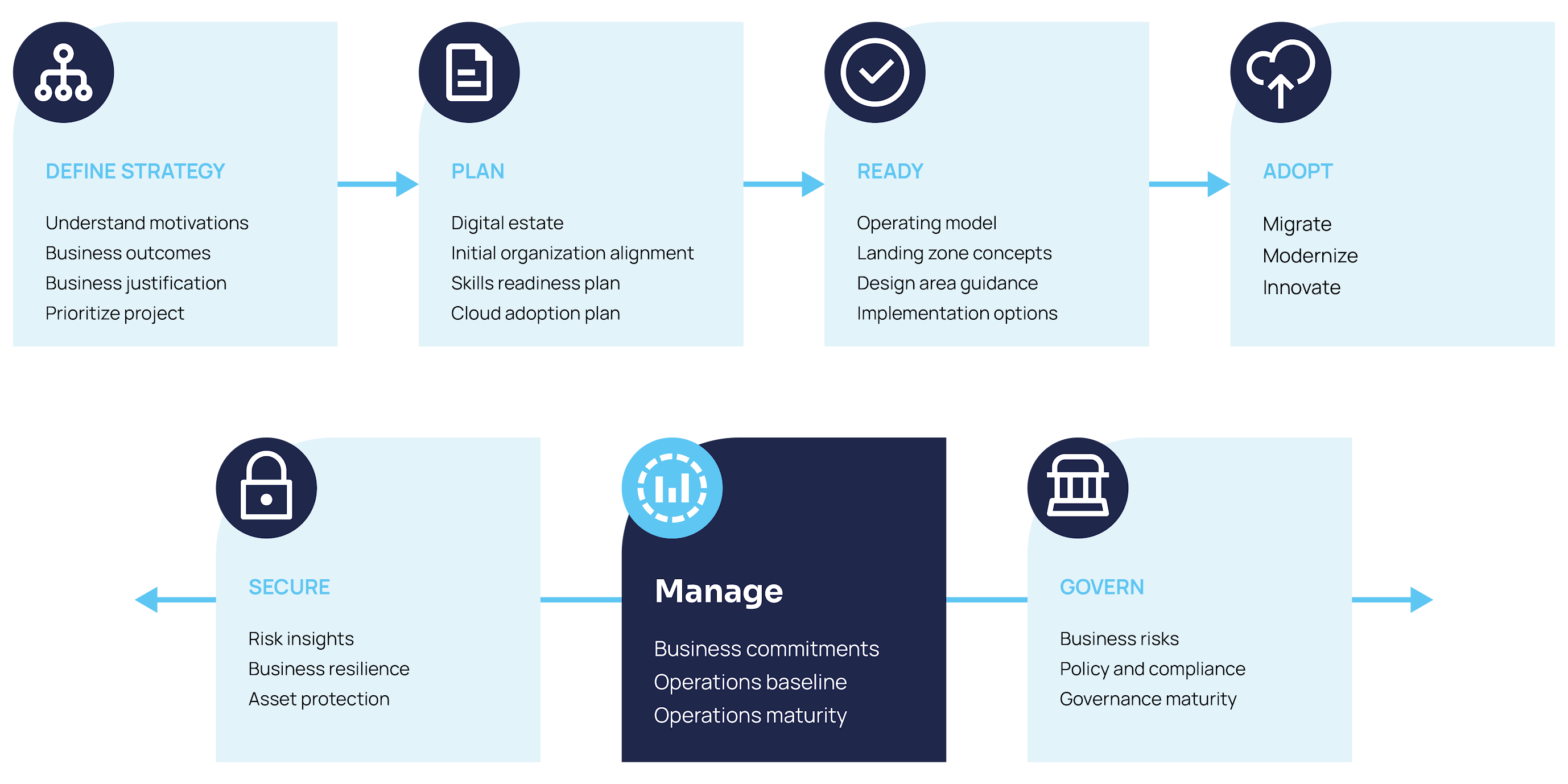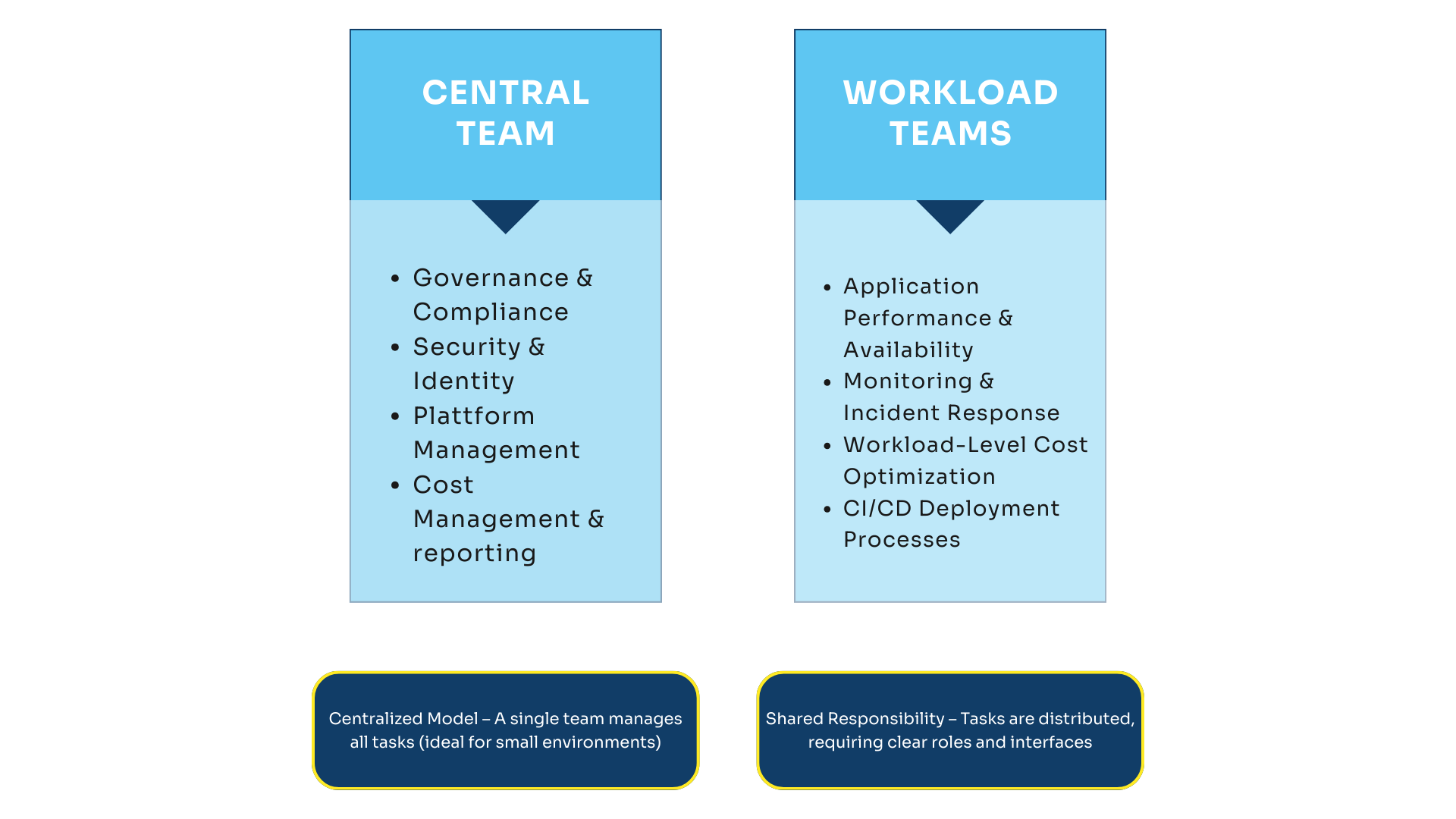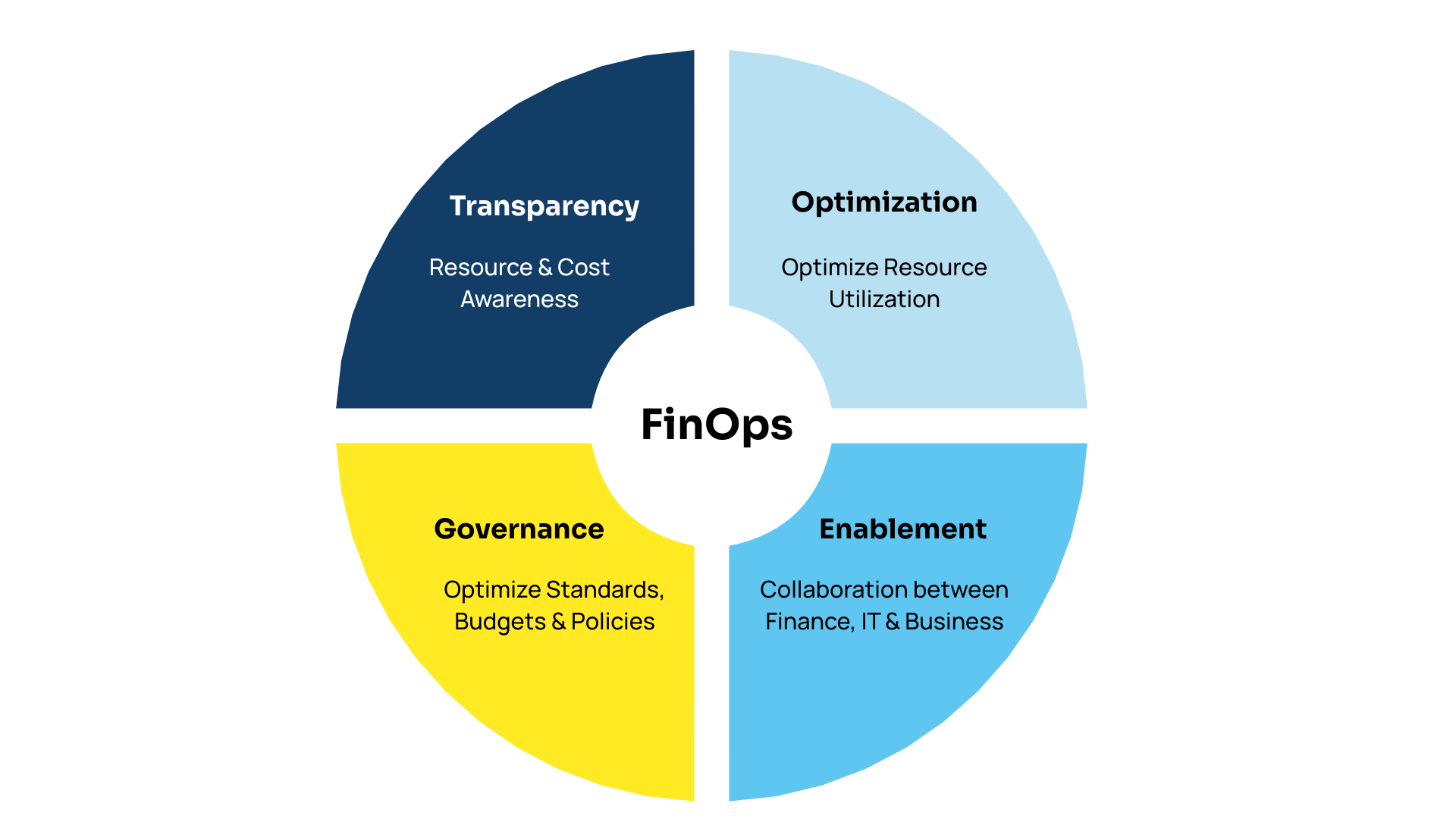Introduction
The journey to the cloud doesn’t end with migration – that’s where it really begins. After successfully moving applications and workloads to Azure, many companies face a new reality: the cloud is complex and requires continuous management. Only those who organize cloud operations professionally can unlock its full potential.
In this article from our series “Successfully Migrate & Modernize with the Microsoft Cloud Adoption Framework”, you’ll learn how to efficiently operate your Azure environment, keep costs under control and establish sustainable operational processes. Key success factors include clear responsibilities, structured workflows, proactive monitoring, automation and active cost and governance management.

Microsoft Cloud Adoption Framework
1. Responsibilities in Cloud-Operations
The foundation of successful cloud operations is a clear understanding of responsibilities. Unlike in traditional on-premises environments, responsibility and control in the cloud are distributed – depending on the deployment model (IaaS, PaaS, SaaS) and the company’s organizational structure. Without clear lines, gaps in security, stability and cost control can quickly arise.
Central responsibilities:
- Governance & Compliance: Policies, regulatory requirements, standards
- Security & Identity Management: Microsoft Entra ID, RBAC/ABAC, Conditional Access
- Platform Management: Subscriptions, networks, central services
- Cost Control & Reporting: Budgets, central FinOps guidelines
Workload responsibilities:
- Application performance & availability
- Monitoring & incident response
- Workload-level cost optimization
- CI/CD deployment processes
Companies can choose different organizational models. In the centralized model, one team manages all monitoring, governance and operations tasks. This simplifies oversight and standardizes processes, making it especially suitable for smaller environments. The shared responsibility model distributes central and workload-specific tasks. While more flexible and scalable, it requires clearly defined roles, responsibilities, and interfaces to avoid overlaps or gray areas.
📌 Conclusion: Without clearly defined responsibilities, gaps quickly emerge, increasing security risks, hindering cost control, and threatening cloud stability. Only a conscious roles-and-responsibilities model enables efficient, secure, and sustainable operation of Azure environments.

Responsibilities in Cloud Operations
2. Monitoring – Proactive instead of Reactive
A core pillar of modern cloud operations is monitoring. In a dynamic Azure environment, reacting to problems is not enough. Companies must continuously monitor their cloud to detect outages early, ensure compliance and identify optimization potential in cost and performance.
Monitoring areas in Azure:
- Service Health: Azure Service Health and Resource Health provide information on outages, planned maintenance and disruptions.
- Security: Monitoring identities, access rights, vulnerabilities and network activity with Microsoft Defender for Cloud, Microsoft Sentinel, and Entra Monitoring.
- Compliance: Ensuring adherence to regulatory requirements and internal policies via Azure Policy and Microsoft Purview Compliance Manager.
- Costs: Microsoft Cost Management ensures transparency of expenses and supports budget and resource optimization.
- Data & Runtime: Sensitive data protection and continuous performance monitoring with Application Insights.
- Cloud Resources: Azure Monitor collects logs, metrics and activity, providing a central view of resource usage and changes.
Proactive alerting is key to preventing disruptions. Dynamic thresholds detect unusual behavior, while escalation paths and severity levels ensure critical incidents are addressed immediately. Action Groups and automation, e.g., via Logic Apps or ITSM integration, speed up responses and reduce team workload.
Visualization & transparency further enhance monitoring efficiency. Dashboards in Azure Monitor or Managed Grafana provide quick insights, while Workbooks allow deeper analysis. KPIs should be tailored to the audience – IT, management, or finance – to enable well-informed decisions for performance, cost, and security optimization.
📌 Conclusion: Monitoring in the cloud is not a one-time task, but a continuous process. Only those who detect risks and opportunities early can run their Azure environment stably, securely, and cost-effectively.
3. Automation & Infrastructure as Code (IaC)
Manual interventions are one of the biggest sources of errors in cloud environments. Even small, ad-hoc changes made through the Azure Portal can cause inconsistencies, security risks or configuration drift. Automation and Infrastructure as Code (IaC) are therefore essential for secure, efficient and traceable operations.
Best practices:
- Change Management: All changes should follow formal processes, including risk assessments, approvals and rollback plans.
- CI/CD Pipelines: Toolchains like GitHub, Azure DevOps or GitHub Actions standardize build, test and deployment, reducing errors and increasing speed.
- Infrastructure as Code: Tools like Bicep, Terraform, or ARM templates ensure consistent, repeatable deployments and simplify rollbacks.
- Portal Deployments as Exceptions: Direct Azure Portal changes are quick but often inconsistent. Templates should always be updated to maintain version-controlled configurations.
Benefits of Automation & IaC:
- Consistency across environments (development, test, production)
- Faster deployments and higher release frequency without quality loss
- Traceability, audit readiness and simplified troubleshooting
📌 Conclusion: Professional cloud operations rely on automation and IaC as foundations for stability, security and efficiency. They enable not just reliable management but also continuous improvement and innovation.
4. Cost Management and FinOps
Without active cost management, cloud spending can quickly spiral out of control. Especially in dynamic environments like Azure, it’s essential to maintain transparency over resources and consumption and actively manage costs. FinOps has emerged as a proven practice for making spending predictable, accountable and efficient.
FinOps in practice:
- Transparency: Teams understand which resources generate which costs, fostering accountability.
- Optimization: Unused or oversized resources are identified and shut down or adjusted.
- Enablement: Finance, IT, and business units work closely together to align financial and technical goals.
- Governance: Standards, budgets and policies prevent sprawl and encourage sustainable cloud use.
Typical measures:
- Pay Less: Use reservations, savings plans or optimized licensing models to reduce long-term costs.
- Use Less: Shut down or downsize unused resources to cut ongoing expenses.
- Cost Alerts: Early warnings on budget overruns allow timely countermeasures.
- Workload Cost Management: Teams take responsibility for the costs of their workloads and make optimization decisions.
💡 Our offer:With the FinOps Quick Check, PCG provides companies with an initial cost optimization assessment. On request, we also support building a comprehensive FinOps framework for transparency, control and continuous optimization.

FinOps
Conclusion
A successful cloud migration is only the beginning – the real challenge comes afterward. Only a clear, structured cloud operations model ensures long-term efficiency, security and cost control.
Key success factors:
- Clear responsibilities: Defined roles between central cloud and workload teams prevent gray areas and increase stability.
- Proactive monitoring: Continuous monitoring prevents outages, ensures compliance and identifies optimization opportunities.
- Automation & IaC: Automated processes and consistent resource management reduce errors, increase speed and ensure audit readiness.
- Strategic cost management with FinOps: Transparency, budget control and workload optimization prevent unexpected costs and promote efficient resource usage.
Companies that integrate these building blocks into their cloud strategy ensure that their Azure environment not only runs reliably but also creates real business value.
👉 Learn more about our Managed Cloud Operations (MCO) offering or start directly with a FinOps Quick Check
to optimize your Azure environment efficiently and cost-effectively:
📅 Coming up next week:
The next and second-to-last article in our series will cover Cloud Governance: how to keep rules, policies, and risks under control, build a governance structure and continuously manage compliance, security and costs. Governance as a central building block for secure and efficient cloud operations.
